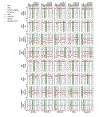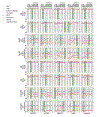Comparing Multiple Machine Learning Algorithms and Metrics for Estrogen Receptor Binding Prediction
- PMID: 30114914
- PMCID: PMC6181119
- DOI: 10.1021/acs.molpharmaceut.8b00546
Comparing Multiple Machine Learning Algorithms and Metrics for Estrogen Receptor Binding Prediction
Abstract
Many chemicals that disrupt endocrine function have been linked to a variety of adverse biological outcomes. However, screening for endocrine disruption using in vitro or in vivo approaches is costly and time-consuming. Computational methods, e.g., quantitative structure-activity relationship models, have become more reliable due to bigger training sets, increased computing power, and advanced machine learning algorithms, such as multilayered artificial neural networks. Machine learning models can be used to predict compounds for endocrine disrupting capabilities, such as binding to the estrogen receptor (ER), and allow for prioritization and further testing. In this work, an exhaustive comparison of multiple machine learning algorithms, chemical spaces, and evaluation metrics for ER binding was performed on public data sets curated using in-house cheminformatics software (Assay Central). Chemical features utilized in modeling consisted of binary fingerprints (ECFP6, FCFP6, ToxPrint, or MACCS keys) and continuous molecular descriptors from RDKit. Each feature set was subjected to classic machine learning algorithms (Bernoulli Naive Bayes, AdaBoost Decision Tree, Random Forest, Support Vector Machine) and Deep Neural Networks (DNN). Models were evaluated using a variety of metrics: recall, precision, F1-score, accuracy, area under the receiver operating characteristic curve, Cohen's Kappa, and Matthews correlation coefficient. For predicting compounds within the training set, DNN has an accuracy higher than that of other methods; however, in 5-fold cross validation and external test set predictions, DNN and most classic machine learning models perform similarly regardless of the data set or molecular descriptors used. We have also used the rank normalized scores as a performance-criteria for each machine learning method, and Random Forest performed best on the validation set when ranked by metric or by data sets. These results suggest classic machine learning algorithms may be sufficient to develop high quality predictive models of ER activity.
Keywords: Bayesian; deep learning; estrogen receptor; machine learning; support vector machine.
Conflict of interest statement
Competing interests:
S.E. is owner, D.P.R. and K.M.Z., are employees and A.M.C is a consultant of Collaborations Pharmaceuticals Inc.
Figures



Similar articles
-
Predictive modeling of estrogen receptor agonism, antagonism, and binding activities using machine- and deep-learning approaches.Lab Invest. 2021 Apr;101(4):490-502. doi: 10.1038/s41374-020-00477-2. Epub 2020 Aug 10. Lab Invest. 2021. PMID: 32778734 Free PMC article.
-
Bioactivity Comparison across Multiple Machine Learning Algorithms Using over 5000 Datasets for Drug Discovery.Mol Pharm. 2021 Jan 4;18(1):403-415. doi: 10.1021/acs.molpharmaceut.0c01013. Epub 2020 Dec 16. Mol Pharm. 2021. PMID: 33325717 Free PMC article.
-
Comparison of Deep Learning With Multiple Machine Learning Methods and Metrics Using Diverse Drug Discovery Data Sets.Mol Pharm. 2017 Dec 4;14(12):4462-4475. doi: 10.1021/acs.molpharmaceut.7b00578. Epub 2017 Nov 13. Mol Pharm. 2017. PMID: 29096442 Free PMC article.
-
A review on machine learning approaches and trends in drug discovery.Comput Struct Biotechnol J. 2021 Aug 12;19:4538-4558. doi: 10.1016/j.csbj.2021.08.011. eCollection 2021. Comput Struct Biotechnol J. 2021. PMID: 34471498 Free PMC article. Review.
-
Review of machine learning and deep learning models for toxicity prediction.Exp Biol Med (Maywood). 2023 Nov;248(21):1952-1973. doi: 10.1177/15353702231209421. Epub 2023 Dec 6. Exp Biol Med (Maywood). 2023. PMID: 38057999 Free PMC article. Review.
Cited by
-
Machine Learning Models Identify New Inhibitors for Human OATP1B1.Mol Pharm. 2022 Nov 7;19(11):4320-4332. doi: 10.1021/acs.molpharmaceut.2c00662. Epub 2022 Oct 21. Mol Pharm. 2022. PMID: 36269563 Free PMC article.
-
Predictive modeling of estrogen receptor agonism, antagonism, and binding activities using machine- and deep-learning approaches.Lab Invest. 2021 Apr;101(4):490-502. doi: 10.1038/s41374-020-00477-2. Epub 2020 Aug 10. Lab Invest. 2021. PMID: 32778734 Free PMC article.
-
Staying Ahead of the Game: How SARS-CoV-2 has Accelerated the Application of Machine Learning in Pandemic Management.BioDrugs. 2023 Sep;37(5):649-674. doi: 10.1007/s40259-023-00611-8. Epub 2023 Jul 18. BioDrugs. 2023. PMID: 37464099 Review.
-
Déjà vu: Stimulating open drug discovery for SARS-CoV-2.Drug Discov Today. 2020 May;25(5):928-941. doi: 10.1016/j.drudis.2020.03.019. Epub 2020 Apr 19. Drug Discov Today. 2020. PMID: 32320852 Free PMC article. Review.
-
Comparing Machine Learning Algorithms for Predicting Drug-Induced Liver Injury (DILI).Mol Pharm. 2020 Jul 6;17(7):2628-2637. doi: 10.1021/acs.molpharmaceut.0c00326. Epub 2020 Jun 8. Mol Pharm. 2020. PMID: 32422053 Free PMC article.
References
-
- Hall JM; Couse JF; Korach KS The multifaceted mechanisms of estradiol and estrogen receptor signaling. J Biol Chem 2001, 276, (40), 36869–72. - PubMed
-
- Giguere V; Yang N; Segui P; Evans RM Identification of a new class of steroid hormone receptors. Nature 1988, 331, (6151), 91–4. - PubMed
-
- Soltysik K; Czekaj P Membrane estrogen receptors - is it an alternative way of estrogen action? J Physiol Pharmacol 2013, 64, (2), 129–42. - PubMed
-
- Journe F; Body JJ; Leclercq G; Laurent G Hormone therapy for breast cancer, with an emphasis on the pure antiestrogen fulvestrant: mode of action, antitumor efficacy and effects on bone health. Expert Opin Drug Saf 2008, 7, (3), 241–58. - PubMed
Publication types
MeSH terms
Substances
Grants and funding
LinkOut - more resources
Full Text Sources
Other Literature Sources

